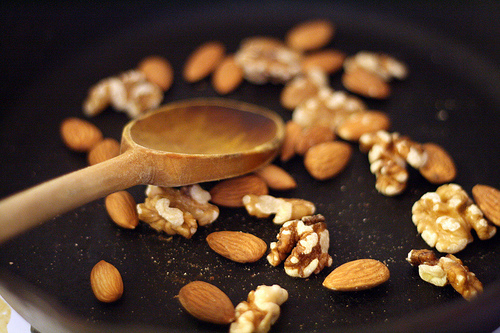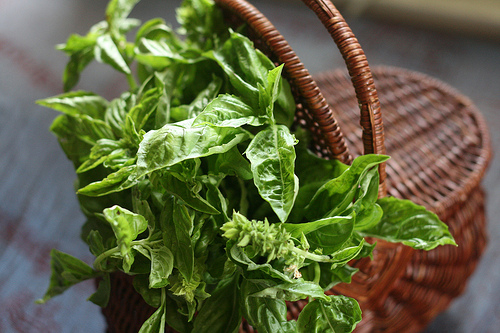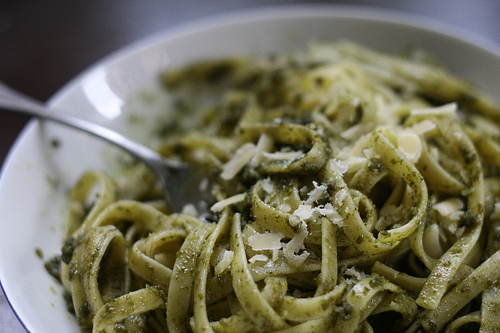I have a confession to make. I’m a pesto snob. ((Anyone who has lived with me, spoken with me, or seen me from afar probably already knows this.)) I spent years sampling store-bought varieties, disappointed with everything in a jar, and nearly all of the fresher, refrigerated ones. While studying abroad in Paris, I lived on yogurt, baguettes, and–yes–pesto. Watching a friend make pesto out of a packet nearly killed me. ((And don’t even get me started on the abomination that is creamy pesto.))
You know that saying? About what to do if you want something done well? And don’t have a celebrated Italian chef locked away in your kitchen cupboard? ((Something I’m working on.)) Clearly, the answer was to find a good pesto recipe and obsessively refine it over the course of several months.
There was only one obstacle remaining. I have this theory about people who love pesto. They say, “Hey! This stuff is great! But also really expensive at my local grocery store. Maybe I should save money and make my own.” And they get as far as the pine nuts, look at the price, ((My grandpa calls tomatoes “red gold”. I’d like to call pine nuts “off-white gold” or maybe “beige gold”, but it just doesn’t have the same ring to it.)) then head straight for the refrigerated pasta section or even (gasp) reach for a jar. “Oh well,” they say, “It would have been nice to make my own fresh pesto.” Well, with this recipe, we could single-handedly revolutionize the way people consume pesto. As long as almonds or walnuts never go up in price.
Poor Woman’s (or Man’s) Pesto ((more photos on Flickr))
- 3 cups fresh basil ((Got mine at–where else–the local farmer’s market.))
- 1/4 cup almonds
- 1/4 cup walnuts (you can substitute all almonds, all walnuts, or–if you are very wealthy–all pine nuts)
- 3-4 cloves garlic
- 1 cup olive oil
- 1/2 cup grated parmesan cheese (I love parmesan, so I used 2/3 cup) ((Note for the vegans: this pesto is also fine without the cheese. Just reduce the amount of oil (otherwise it will be too liquid) and add a little salt.))
Toast the almonds and walnuts in a pan over medium heat until they begin to brown. Crush them with a mortar and pestle.
Grate the cheese and chop the garlic.
Chop your beautiful, fresh basil (we’re doing this last so the basil stays beautiful and fresh).
Stick everything (basil, garlic, cheese, nuts, and oil) in the blender. Pulse until smooth. The pesto should be thick, but still pour easily. Add oil a little at a time if it’s too dry.
Serve immediately over hot pasta. ((My favorite pesto pasta is spinach fettuccine. Rotini and ziti are also great, and shells hold little pockets of pesto.)) Remember, never heat pesto, as this ruins the flavor. It should always be served cold over just-boiled pasta, and the heat from the noodles will warm the pesto. If you’re as parmesan-obsessed I am, you can grate some extra cheese over your pasta.
To store your extra pesto, transfer to a jar or container and pour a thin layer of olive oil over the top. This is to prevent the basil from oxidizing and turning an unappealing brown color. You can also freeze leftover pesto. I usually pour it into an ice cube tray, then transfer the frozen pesto cubes into another container. (Much easier than gouging pieces out of a frozen vat of pesto, or having to defrost more than you need.) Each cube is about one serving.








I’ve never paid much attention to the price of pine nuts tho I do tend to buy them in bulk to get a good price. For me, it’s the price of genuine parmigiana-reggiano that hurts.
PS, pesto tastes equally good in a nice risotto!
Mouth-watering. Love the photos and simple instructions. Worth mentioning oxidized pesto is still edible and tasty, all else being equal. In other words, oxidized doesn’t equal spoiled. Thanks for another delicious post!
[…] finished pesto Image by Serenae Recipe: serenae.com/2010/08/15/poor-womans-pesto/ […]